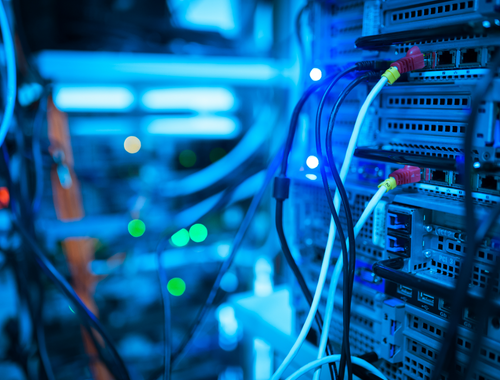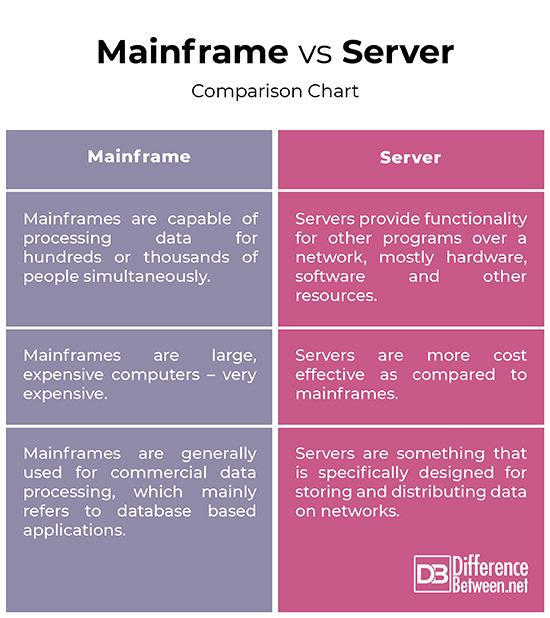Difference Between Mainframe and Server
Today’s most powerful computers are mainframes, servers and supercomputers. These are the most powerful machines used in large scale businesses and government agencies. They are more than capable of processing and handling massive amounts of data at very fast speeds. Today, we are going to discuss what are servers and what are mainframes, and understand the differences between the two. So, keep reading to know more.

Mainframe
Mainframe is kind of a computer, but a really big, expensive and powerful one that is insanely capable of simultaneously processing data for hundreds or thousands of people. They are like massive computers housed in bug closet-sized cabinets and large components are added for storage and output. A mainframe installation can fill a good-sized room. They are generally known for their insane size, amount of storage, and high processing power. Mainframes are typically used by businesses and government agencies to provide centralized, processing and management for huge piles of data.

Server
Server, as the name suggests, is kind of a computer or system that can provide services to a suite of other computers or systems, also known as the client. It is a piece of computer hardware that provides functionality for other programs over a network. It is like a centralized storage system that serves data to computers connected to a network. When you enter a web address in the browser or search for something in Google, the data or information you get is provided by servers. In its simplest sense, you can think of a server as your home desktop computer but with more power, more CPU, more RAM, and more grunt.
Difference between Mainframe and Server
Data Handling
– Mainframes are basically big closet-sized computers that are generally designed to manage large workloads and large processing power requirements. They are capable of simultaneously processing data for hundreds or thousands of people. They are not as commonly used today as they used to be. A server, on the other hand, provides functionality for other programs over a network, mostly hardware, software and other resources.
Storage
– Servers, as the name suggest, serve data to computers connected to a network. They are like a centralized storage system for storing programs, data and information. Technically, just about any computer can be configured to work and behave like a server. But they are generally classified as something that is specifically designed for storing and distributing data on networks. Mainframes are generally used for commercial data processing, which mainly refers to database based applications.
Money
– One of the major differences between the two is cost effectiveness. Mainframes are large, expensive computers – very expensive. And we’re not just considering hardware and software, there are other major expenses involved, such as hardware support costs, software licensing costs, and a lot more. Plus you need more people to look after a mainframe which also adds up to the overall cost. Servers are more cost effective as compared to mainframes.
Mainframe vs. Server: Comparison Chart

Summary
In the internet world, we are all surrounded by data and you need some sort of medium to serve those data. Server is that medium; it’s like a program or specialized hardware that serves data and information. It provides a central storage for instructions and data – huge amounts of data. Servers can be of all kinds like database servers, file servers, application servers and so on. Well, almost everything you see and access on the internet or the web is stored on a server. Mainframes are physically bigger than a commodity server and serve a different purpose. They are capable of processing high volume of transactions and quickly. Mainframes require high and regular maintenance.
Is server better than mainframe?
Better or not, servers are definitely more cost effective than mainframes. Because there are fewer costs involved, servers are relatively easy to manage and maintain.
Is mainframe used for server?
Mainframes are critical to commercial databases and transaction servers.
What are the differences between a server and mainframe and a supercomputer?
Super computers are custom built for specific purposes, such as research or anything that requires a lot of number crunching; mainframes are like really large, expensive computers capable of processing and handling insane amounts of data; and servers are like centralized storage systems that store, send and receive data in a network.
What is the difference between mainframe and client server architecture?
Client server architecture is where a client makes a request from a centralized server (host computer) whereas in a mainframe system, a single powerful computer is responsible for all the processing.
Is mainframe a backend?
A mainframe is the central data repository that provides storage, processing and management for insane amounts of data. So, large enterprises and government agencies leverage such mainframe resources on the backend.
Is mainframe a database?
No, mainframes are not databases. In fact, you can think of them as data servers designed for large scale processing of data and information.
What is difference between mainframe and COBOL?
Mainframe is like a computer and COBOL is the application programming language of the mainframe world.
What OS do mainframes use?
The widely used operating system for mainframes is z/OS, which is developed by IBM for its family of z/Architecture mainframe computers.
What are the examples of mainframe computer?
Some common examples of a mainframe computer are the HITAC S-3800 and the ZSeries mainframe computer from IBM.
- Difference Between Caucus and Primary - June 18, 2024
- Difference Between PPO and POS - May 30, 2024
- Difference Between RFID and NFC - May 28, 2024
Search DifferenceBetween.net :
Leave a Response
References :
[0]Held, Gilbert. Server Management. Florida, United States: CRC Press, 2000. Print
[1]Shinder, Debra Littlejohn. Computer Networking Essentials. Indiana, United States: Cisco Press, 2001. Print
[2]Parsons, June Jamrich. New Perspectives on Computer Concepts 2018: Introductory. Massachusetts, United States: Cengage Learning, 2017. Print
